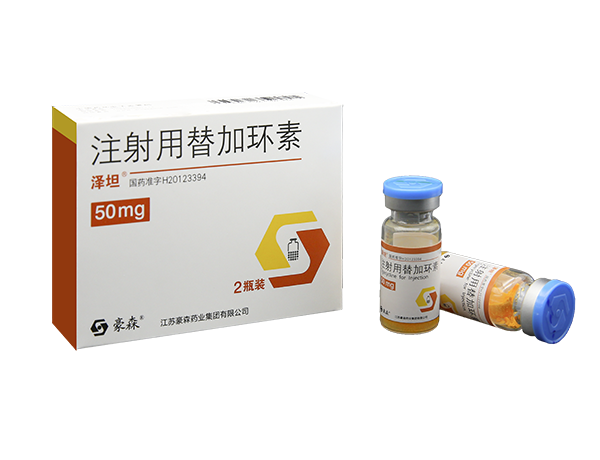The main ingredient of this product is Tigecycline.
Chemical Name: (4S, 4aS, 5aR, 12aS)-9-(2-tert-butylaminoacetamido)-4,7-bisdimethylamino-1,4,4a,5,5a,6,11,12a - octahydro-3,10,12,12a-tetrahydroxy-1,11-dioxo-2-naphthacenecarboxamide

| 【Ingredient】 | The main ingredient of this product is Tigecycline. Molecular Formula: C29H39N5O8 Molecular Weight: 585.65 |
|---|---|
| 【Description】 | This product is orange loose cake or powde |
| 【Indication】 | This product is indicated in patients 18 years of age and older for the treatment of the following infections caused by susceptible isolates of specific bacteria: Complicated Intra-abdominal: Infections caused by susceptible isolates of Citrobacter freundii, Enterobacter cloacae, Escherichia coli, Klebsiella oxytoca, Klebsiella pneumoniae, Enterococcus faecalis (vancomycin-susceptible isolates), Staphylococcus aureus (methicillin-susceptible and -resistant isolates), Streptococcus anginosus grp. (includes S. anginosus, S. intermedius, and S. constellatus), Bacteroides fragilis, Bacteroides thetaiotaomicron, Bacteroides uniformis, Bacteroides vulgatus, Clostridium perfringens, and Peptostreptococcus micros. Complex Skin and Soft Tissue Infections: Infection caused by susceptible isolates of Escherichia coli, Enterococcus faecalis (vancomycin-susceptible isolates), Staphylococcus aureus (methicillin-susceptible and -resistant isolates), Streptococcus agalactiae, Streptococcus anginosus grp. (includes S. anginosus, S. intermedius, and S. constellatus), Streptococcus pyogenes, Enterobacter cloacae, Klebsiella pneumoniae, and Bacteroides fragilis. Community-Acquired Pneumonia: Infection caused by susceptible isolates of Streptococcus pneumoniae (penicillin-susceptible isolates), Haemophilus influenza (β-lactamase-negative isolates), Legionella pneumophila, including cases with concurrent bacteremia. Appropriate specimens for bacteriological examination should be obtained in order to isolate and identify the causative organisms and to determine their susceptibility to this product. This product may be initiated as empiric monotherapy before results of these tests are known. To reduce the development of drug-resistant bacteria and maintain the effectiveness of this product and other antibacterial drugs, this product should be used only to treat infections that are proven or strongly suspected to be caused by susceptible bacteria. When culture and susceptibility information are available, they should be considered in selecting or modifying antibacterial therapy. In the absence of such data, local epidemiology and susceptibility patterns may contribute to the empiric selection of therapy. This product should be reserved for use in situations when alternative treatments are not suitable |
| 【Strength】 | 50 mg |
| 【Dosage and Administration】 | 1, Recommended Adult Dosage The recommended dosage regimen for this product is an initial dose of 100 mg (2 vials), followed by 50 mg (1 vial) every 12 hours. Intravenous infusions of this product should be administered over approximately 30 minutes to 60 minutes every 12 hours. The recommended duration of treatment with this product for complicated intra-abdominal infections is 5 days to 14 days. The duration of therapy should be guided by the severity and site of the infection and the patient’s clinical and bacteriological progress. 2, Dosage in Patients With Hepatic Impairment No dosage adjustment is warranted in patients with mild to moderate hepatic impairment (Child Pugh A and Child Pugh B). In patients with severe hepatic impairment (Child Pugh C), the initial dose of this product should be 100 mg (2 vials) followed by a reduced maintenance dose of 25 mg (half vial) every 12 hours. Patients with severe hepatic impairment (Child Pugh C) should be treated with caution and monitored for treatment response. 3. Dosage in Patients with Renal Impairment or in Patients Undergoing Haemodialysis No dosage adjustment is necessary in patients with renal impairment or in patients undergoing haemodialysis. 4. No dosage adjustment based on the age, sex or ethnicity is warranted in patients 18 years of age and older. Storage of Reconstituted Solution: Parenteral drug products should be inspected visually for particulate matter and discoloration (e.g., green or black) prior to administration. Once reconstituted, this product may be stored at room temperature for up to 24 hours (up to 6 hours in the vial and the remaining time up to 18 hours in the intravenous bag). Alternatively, this product mixed with 0.9% Sodium Chloride Injection, or 5% Dextrose Injection, may be stored refrigerated at 2°C to 8°C for up to 48 hours following immediate transfer of the reconstituted solution into the intravenous bag or other suitable infusion container (such as a glass bottle). Administration of the Diluted Solution: This product may be administered intravenously through a dedicated line or through a Y-site. If the same intravenous line is used for sequential infusion of several drugs, the line should be flushed before and after infusion of this product with 0.9% Sodium Chloride Injection or 5% Dextrose Injection. Injection should be made with an infusion solution compatible with Tigecycline and with any other drug(s) administered via this common line. Compatible intravenous solutions include 0.9% Sodium Chloride Injection, 5% Dextrose Injection, and Lactated Ringer's Injection (USP). When administered through a Y-tube, this product is compatible with the following drugs or diluents when used with 0.9% Sodium Chloride Injection or 5% Dextrose Injection: amikacin, dobutamine, dopamine HCl, gentamicin, haloperidol, Lactated Ringer's, lidocaine HCl, metoclopramide, morphine, norepinephrine, piperacillin/tazobactam (EDTA formulation), potassium chloride, propofol, ranitidine HCl, theophylline, and tobramycin. The following drugs should not be administered simultaneously through the same Y-site as this prodcut: amphotericin B, amphotericin B lipid complex, diazepam, esomeprazole and omeprazole |
2012: First-to-market generic drug in China
2013: Jiangsu Hi-Tech Product
2017: Included in NRDL